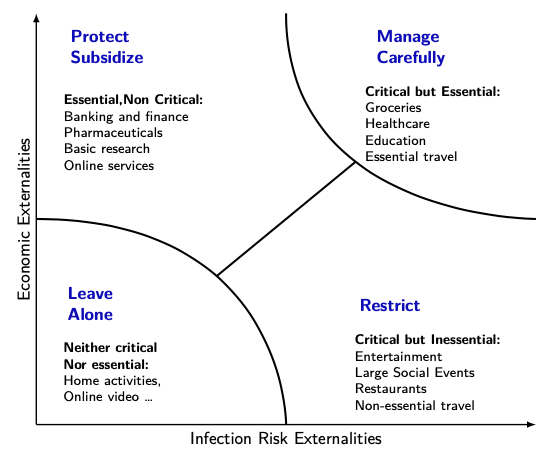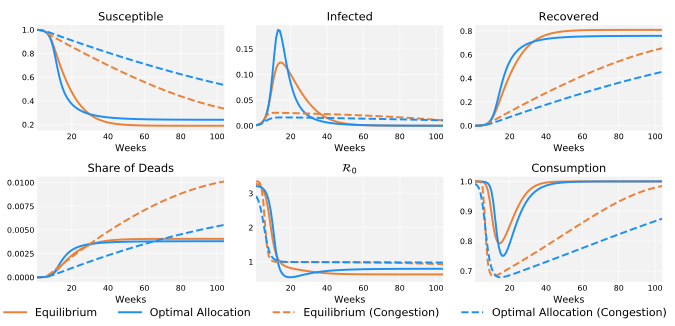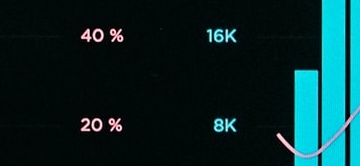By Tiziana Assenza, Fabrice Collard, Martial Dupaigne, Patrick Feve, Christian Hellwig, Sumudu Kankanamge, Nicolas Werquin.
At the time of writing, the COVID-19 pandemic is affecting 187 countries. More than 4 million individuals have been infected worldwide, and more than 280,000 have died. Tens of millions have lost their jobs and GDP has dropped precipitously in many countries. This is the greatest global health crisis in a hundred years, and it is quickly becoming the greatest economic crisis in almost as long.
What strategies should governments adopt to prevent the COVID-19 pandemic from spreading further while mitigating its economic costs? Ultimately, how should governments weigh up competing economic and health policy objectives?
The hammer and the dance
Most governments are following a two-phase strategy to deal with the pandemic. They responded initially with a strong confinement stage that has temporarily limited economic activity in order to control the spread of the pandemic – the hammer. Simultaneously, they have implemented economic rescue packages to shield firms and households from negative economic spillovers.1 However, there are important cross-country differences in the lockdown intensities and durations, and in the reliance on public enforcement versus private incentives.
Some governments have already started the second phase of gradual lifting of confinement measures and subsequent restarting of economic activity. During this second phase, the pandemic must be kept under control while it is still not completely suppressed – the dance. Pueyo (2020) describes this ‘hammer and dance’ strategy to pandemic control from an epidemiological perspective.
The path towards recovery raises additional questions: How fast should lockdown measures be lifted? How should optimal deconfinement be structured? How much can policymakers rely on private incentives?
Health imperatives and economic costs
Two attributes make COVID-19 challenging to control: its fast propagation and the asymptomatic nature of many infections. In Assenza et al. (2020), we analyse optimal economic policy during a pandemic crisis with these attributes.
We argue that the epidemiological strategies to control the COVID-19 crisis are also sound from an economic perspective: controlling the pandemic has economic benefits that go beyond the medical benefits of reducing congestion in hospitals or gaining time to develop a cure or a vaccine.2
Laissez-faire equilibrium and optimal policies both follow the hammer and dance approach, but they differ in the design, strength, and duration of confinement measures. Health and economic policy objectives are thus not mutually exclusive during a pandemic emergency.
The shadow price of infection risks
We summarise the static trade-off between economic activity and infection risks and future mortality that individuals and governments face with a simple tool – the shadow price of infection risks.3 Static policy design (which sectors to open or close) aligns private and social marginal rates of substitution between prosperity and mortality to this shadow price. Dynamic policy design (the timing of interventions) tracks the evolution of this shadow price over the course of the pandemic. Here we summarise the main policy insights.
Sectoral policy interventions
Optimal sectoral policies should target relative rather than absolute magnitudes of infection risk spillovers from face-to-face interactions and economic exposures from sudden changes in spending patterns, demand shortfalls, or supply chain disruptions.

Figure 1 illustrates this principle by classifying economic activities with respect to infection risk and economic spillovers:
Restrict activities that generate strong infection risk externalities but weak economic externalities (e.g. restaurants, cinemas).
Protect or subsidise essential economic activities that have strong positive economic spillovers, especially if they exert weak infection risk externalities (e.g. banking, pharmaceuticals).
Carefully manage activities that are both economically essential and have high infection risk spillovers (e.g. healthcare, education). These sectors have the strongest impact on welfare.
Managing static externalities is key to minimising the economic costs: don't make the pandemic more costly than necessary!
Dynamic policy: Flatten the curve
The dynamics of laissez-faire and optimal policies follow the hammer and dance sequencing. Figure 2 illustrates these dynamics for two versions of our model: a benchmark without medical sector congestion, and an extension with congestion externalities.
The hammer takes place during the first 15 weeks. During this phase equilibrium and optimal policies flatten the infection curve to slow down the propagation of infections and improve individual survival rates. Our simulation suggests a 20% drop in consumption at the equilibrium and a slightly delayed and larger drop of 24% at the optimal policy.
The rationale for flattening the infection curve emerges without reference to the medical arguments in favour of such policies: at our benchmark, flattening the curve serves neither to gain time until a vaccine or cure is found nor to decongest the medical sector. Medical congestion or vaccines substantially strengthen the rationale for early lockdowns at both the equilibrium and the optimal policy.
During the dance, the epidemic slowly progresses until eventually reaching herd immunity. It is kept under control with very persistent economic restrictions that keep the effective transmission rate (R0), i.e. the number of follow-up infections that each infection generates, just below 1.
Figure 2 Policy dynamics without and with medical congestion externalities

The key distinction between laissez-faire and optimal policies is that individuals ‘live in the moment’ – they are only concerned with immediate trade-offs between economic activity and infection risks, but take future dynamics as given. The optimal policy must instead be forward-looking and internalise the impact of current choices on the entire future dynamics. We interpret these dynamic externalities as immunisation and infection spillovers – agents internalise neither the social benefits of immunisation nor that risking an infection potentially exposes others to higher infection risks later on.4
The hammer: With or without an early peak?
The laissez-faire response to high contemporaneous infection risks reduces activities ‘until the worst is over’. This voluntary lockdown lowers the peak infection rate but also slows the propagation and delays the recovery. Besides the direct economic costs of reduced activity, the early lockdown has indirect costs from the need to maintain restrictions for longer during the subsequent recovery.
The social benefits of early lockdowns instead depend on the long-term perspectives: How will we exit the pandemic? When will a vaccine be available? How well is our medical system equipped to deal with the peak of infections?
At our benchmark, the best long-term strategy is to build herd immunity so that the optimal policy is more permissive than the laissez-faire policy early on: the equilibrium fails to internalise the benefits of immunisation.5 With medical congestion, the mortality costs of the initial infection peak are much higher, but not fully internalised by individuals. The optimal policy thus implements even earlier and stronger lockdowns and even slower recovery than the laissez-faire policy.
The dance: Resist the temptation
Dynamic infection externalities instead are strongest during deconfinement, which occurs uniformly faster at the laissez-faire equilibrium and results in uniformly higher long-run mortality than at the optimal policy. While the total number of infections is very low, the effective transmission rate is close to 1, so each infection constitutes the beginning of an arbitrarily long infection chain. The social costs of each infection are equal to the costs of this entire chain and thus far greater than the private costs.
This generates strong pressures to deconfine faster than at the optimum: individuals are eager to ease restrictions when infection risks are diminishing, but the optimal policy internalises the cost of the entire infection chain that comes with each additional infection.
The stakes for de-confinement are high: this phase determines whether the initial lockdown truly saved lives, or merely postponed deaths to a later phase of the pandemic.
Conclusion: Dynamic policy priorities
We translate these results into the following dynamic policy priorities:
Policy must be able to control new infections at all times.
The hammer: early, decisive action is warranted if it helps to save lives in the long run. If it merely delays infections in the short run, it just lengthens the recovery and inflicts higher economic costs.
The dance: optimal deconfinement eases economic restrictions as much as possible while keeping the pandemic’s transmission rate below 1. Policy must control the epidemic, not the other way around.
Beware of dynamic infection spillovers: be patient during deconfinement and do not pay for faster recovery with higher mortality. Do not count on private agents to fully understand the risks they pose to others.
The value of herd immunity really depends on whether there exist better long-term alternatives (a cure or a vaccine), and at what horizon.
In many respects, these policy prescriptions are not too far from the ones suggested by epidemiologists. This comes as no surprise, as the dynamics of optimal policy are dictated by the dynamics of the epidemic. They are nevertheless well grounded in basic economic principles: the shadow price of infection risks, the trade-off between mortality and economic prosperity, and dynamic immunisation and infection spillovers.
Health and economic objectives are not mutually exclusive.
References
- Assenza, T, F Collard, M Dupaigne, P Fève, C Hellwig, S Kankanamge and N Werquin (2020), "The Hammer and the Dance: Equilibrium and Optimal Policy during a Pandemic Crisis", CEPR Discussion Paper 14731.
- Baldwin, R and B Weder di Mauro (eds) (2020a), Economics in the Time of COVID-19, a VoxEU.org eBook, CEPR Press.
- Baldwin, R and B Weder di Mauro (eds) (2020b), Mitigating the COVID-19 Economic Crisis: Act Fast and DO Whatever It Takes, a VoxEU.org eBook, CEPR Press.
- Bethune, Z and A Korinek (2020), "COVID-19 infection externalities: Herd immunity versus containment strategies", VoxEU.org, May
- Ornelas, E (2020), "Managing economic Lockdowns in an epidemic", VoxEU.org, March.
- Pueyo, T (2020), "The Hammer and the Dance", Blog Post, March.
- Toda, A (2020), "Early draconian social distancing may be suboptimal for fighting the COVID-19 Pandemic" VoxEU.org, April.
Endnotes
- 1 See Baldwin and Weder (2020a, 2020b) for a comprehensive discussion.
- 2 Ornelas (2020) presents related arguments informally.
- 3 The price of face masks provides an empirical proxy for the shadow price of infection risks.
- 4 Bethune and Korinek (2020) quantify these externalities.
- 5 Toda (2020) argues that delaying lockdowns may be efficient when they cannot be extended for too long.










